Husband and Wife
Most Intimate Yet Most Distant
Imperial marriages were an integral part of the government institution. They mainly were arranged to raise the political status of the consorts' families and consolidate the emperor's authority and did not easily reflect the private feelings of the emperor and his consorts. However, we can still make inferences about the romantic world behind the vermilion walls through a number of cultural relics and historical documents.
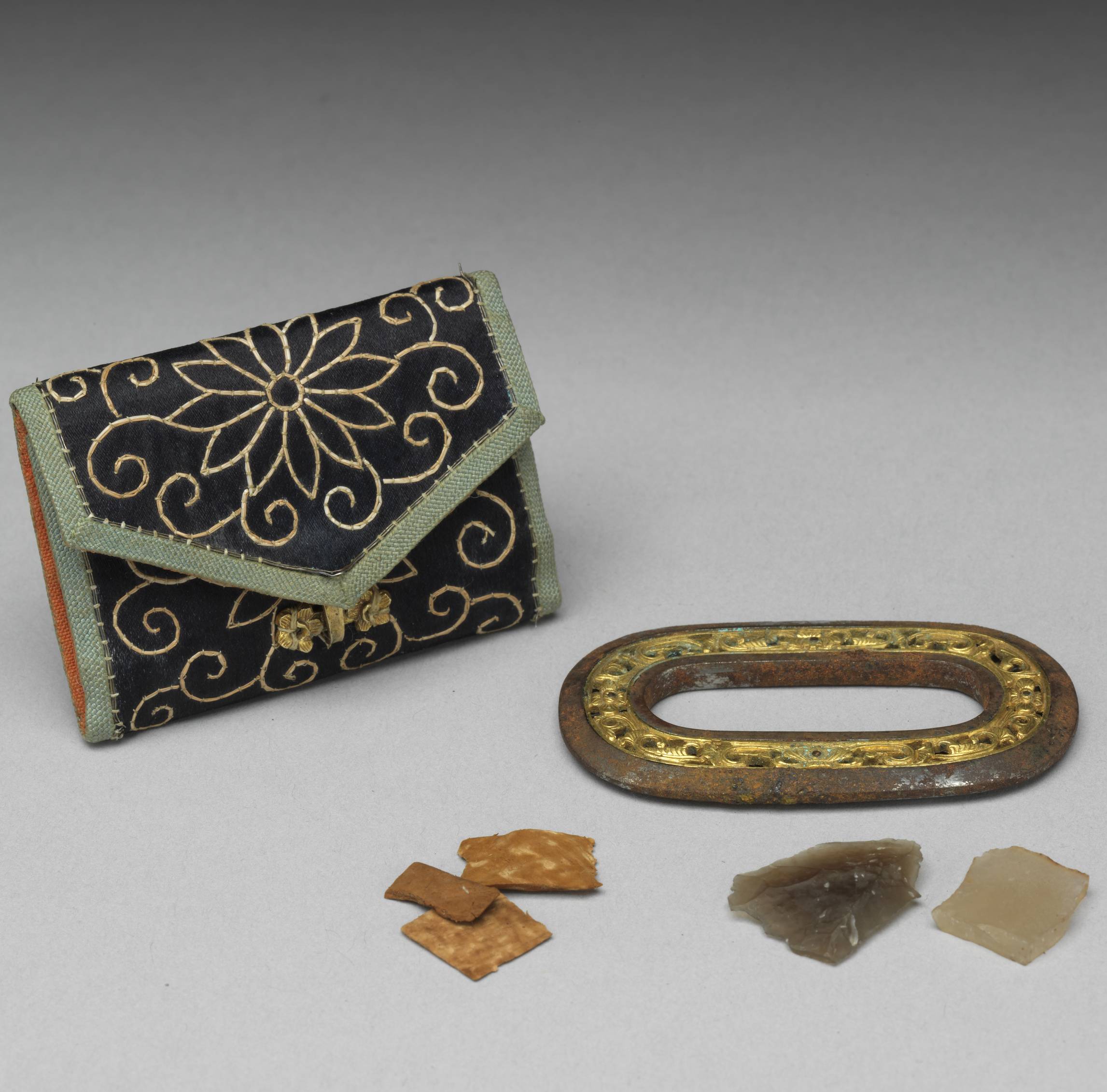
The Qianlong Emperor
and
Empress Xiaoxian
The Guangxu Emperor
and
Empress Longyu
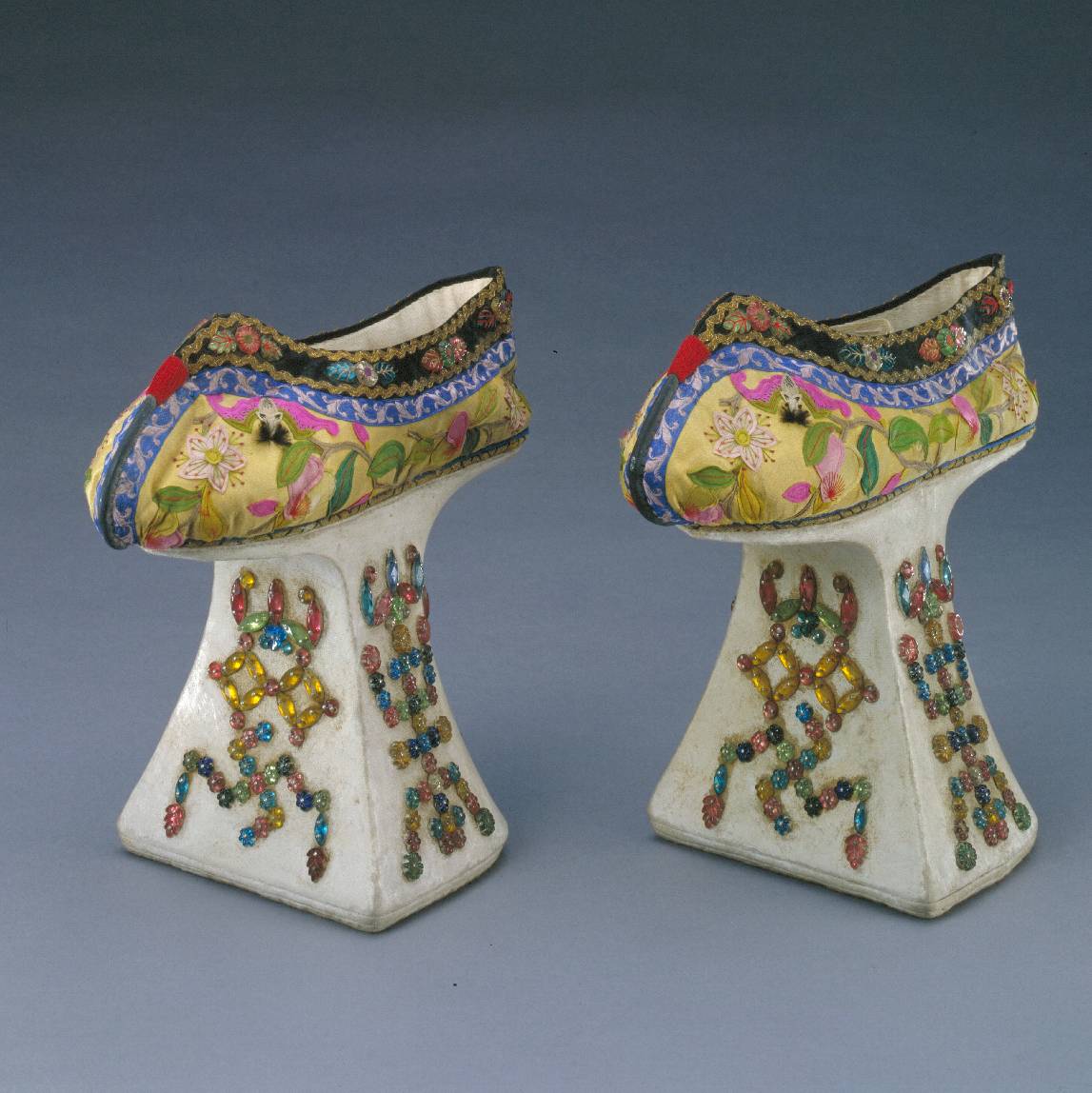
The Qianlong Emperor
and
Empress Xiaoxian
At 17, Prince Hongli took the 16-year-old Lady Fuca (1712-1748) as his wife. Lady Fuca was born into a clan of Manchu nobility and was the daughter of a prominent family. After his accession to the throne, the Qianlong Emperor conferred the title of empress on her. They had two sons and two daughters, but unfortunately the sons and one of the daughters died prematurely. In the spring of the thirteenth year of Qianlong (1748), the Qianlong Emperor brought the empress with him on an inspection of Shandong to ease her pain of losing a son, but she died of a cold during the journey. She was 37-year-old. The emperor personally gives her the honorary posthumous name Xiaoxian (meaning "filial pious and virtuous"). The Qianlong Emperor later channelled his emotions into poetry, composing over a hundred poems mourning her death.
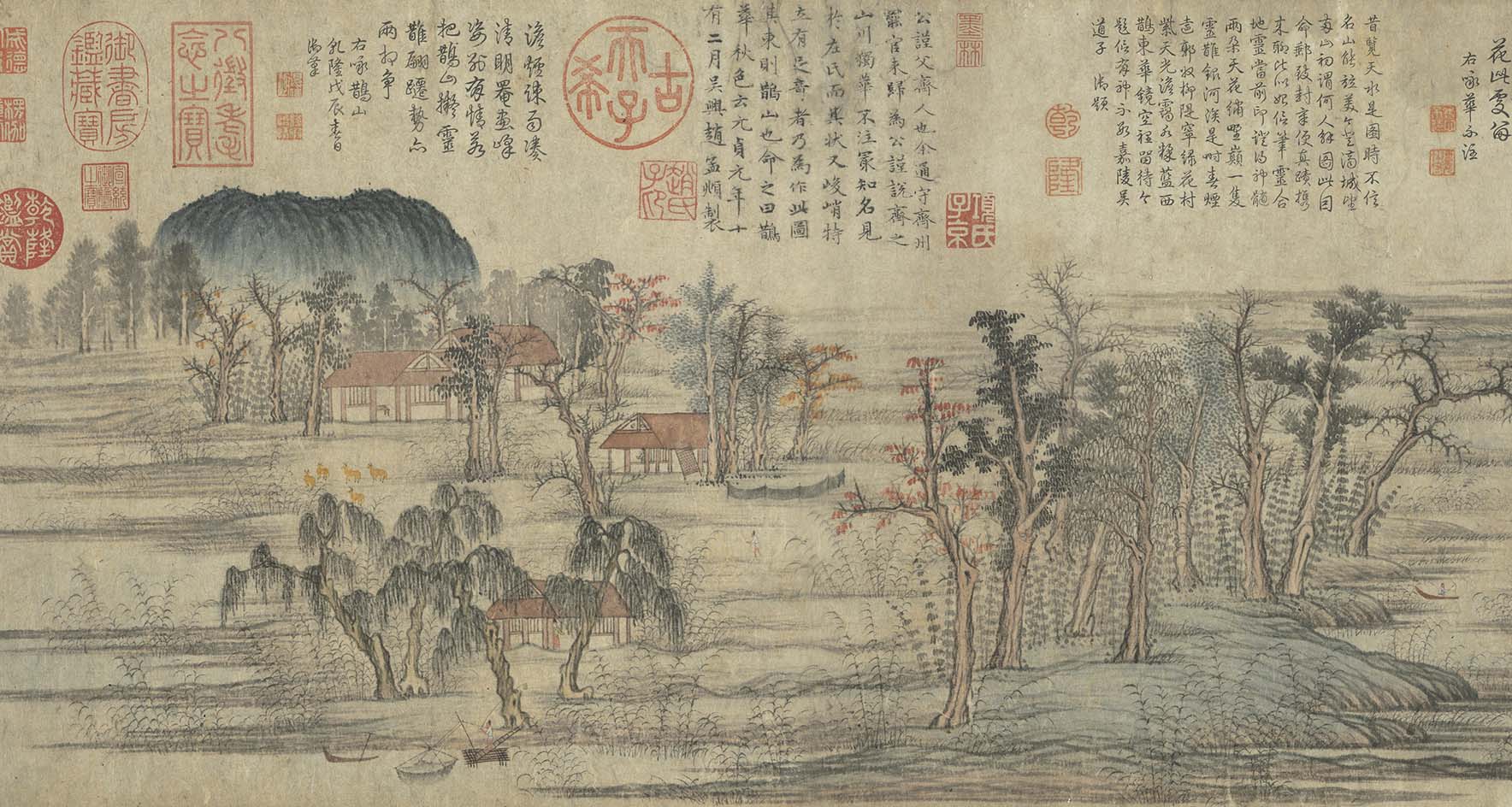
Handscroll of Autumn Colours on the Que and Hua Mountains, 1295 (Yuan Dynasty)
From the collection of the National Palace Museum, Taipei
The Qianlong Emperor frequently inscribed poems and affixed his seals on famous paintings, a practice which some from later generations have frowned upon. Amidst the sea of characters, Qianlong densely calligraphed on Zhao Mengfu (1254-1322)'s handscroll of Autumn Colours on the Que and Hua Mountains was an unintentional revelation of his affection for the Empress Xiaoxian.
In the 13th year of his reign (1748), Qianlong, accompanied by the empress, was on a Shandong excursion. They were on the Quehua Bridge over the Daming Lake, admiring the landscape as it had been depicted in the scroll. There, the emperor was inspired to pen a poem with verses which questioned the need for a que (which meant "magpie") bridge, since Daming Lake was not the 'galaxy'. According to Chinese folklore, the mythical couple Cowherd and Weaver Girl were allowed to meet just once a year on the Magpie Bridge in the Milky Way. With the empress by his side, Qianlong would obviously not need such a bridge to see her.
Soon afterwards, however, the empress died of an illness. Qianlong was overwhelmed with grief. He nevertheless led the cortege back to the capital. When Qianlong viewed the handscroll again a year later, he wrote another poem on it. This time, he lamented that although the scenery remained unchanged, his empress was no longer with him.

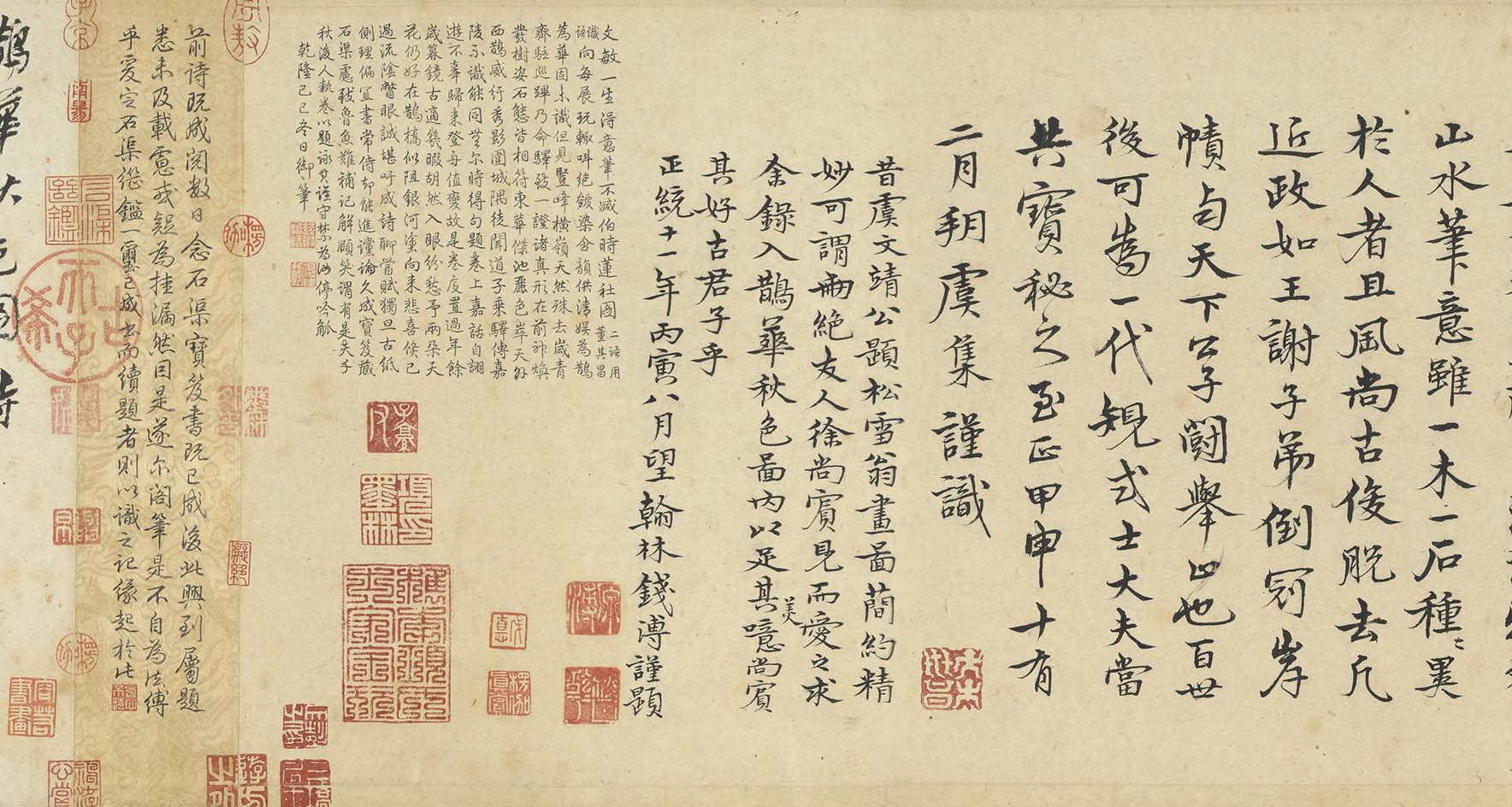

Elegy, Qianlong period, Qing Dynasty
Provided by the Palace Museum
The elegy he composed for his departed wife was particularly moving among the hundred or more poems the Qianlong Emperor wrote to mourn death. In it, he mentioned the shock of her sudden passing after their twenty-two years of marital bliss, even though he knew she had been very sad about losing her young sons. The sight of her personal belongings reminded him of the times they shared, and he mused on who would be by his side in his remaining years.
During the funeral rites, Qianlong severely reprimanded his eldest son Yonghuang (1728-1750) for not mourning appropriately, being devoid of sincerity and treating the interment ceremonies like ordinary errands. The prince's tutor was also punished by forfeiting his salary for three years. The Minister of Justice was beheaded for making an error in the documentation. Out-of-town officials who did not petition for permission to attend the empress' funeral in the capital were either demoted or had their military honours withdrawn. The irate Qianlong labelled them heartless rebels and shameless fame-seekers.


Portraits of the Qianlong Emperor and His Twelve Consorts, Qianlong period, Qing Dynasty
Provided by JOHN L. SEVERANCE FUND
From the collection of The Cleveland Museum of Art
During his lifetime, the Qianlong Emperor had taken numerous wives and concubines. This handscroll, containing the likenesses of Qianlong, the Empress Xiaoxian and eleven of Qianlong's other consorts, took almost forty years to complete.
Originally entitled Xinxie zhipingtu (Mind Picture of a Well-governed and Tranquil Reign), this handscroll was so named by Qianlong himself. The term "zhiping" embodied his reverence for the Confucian values regarding self-discipline that would lead to harmony at home, and eventually to good governance of the country.
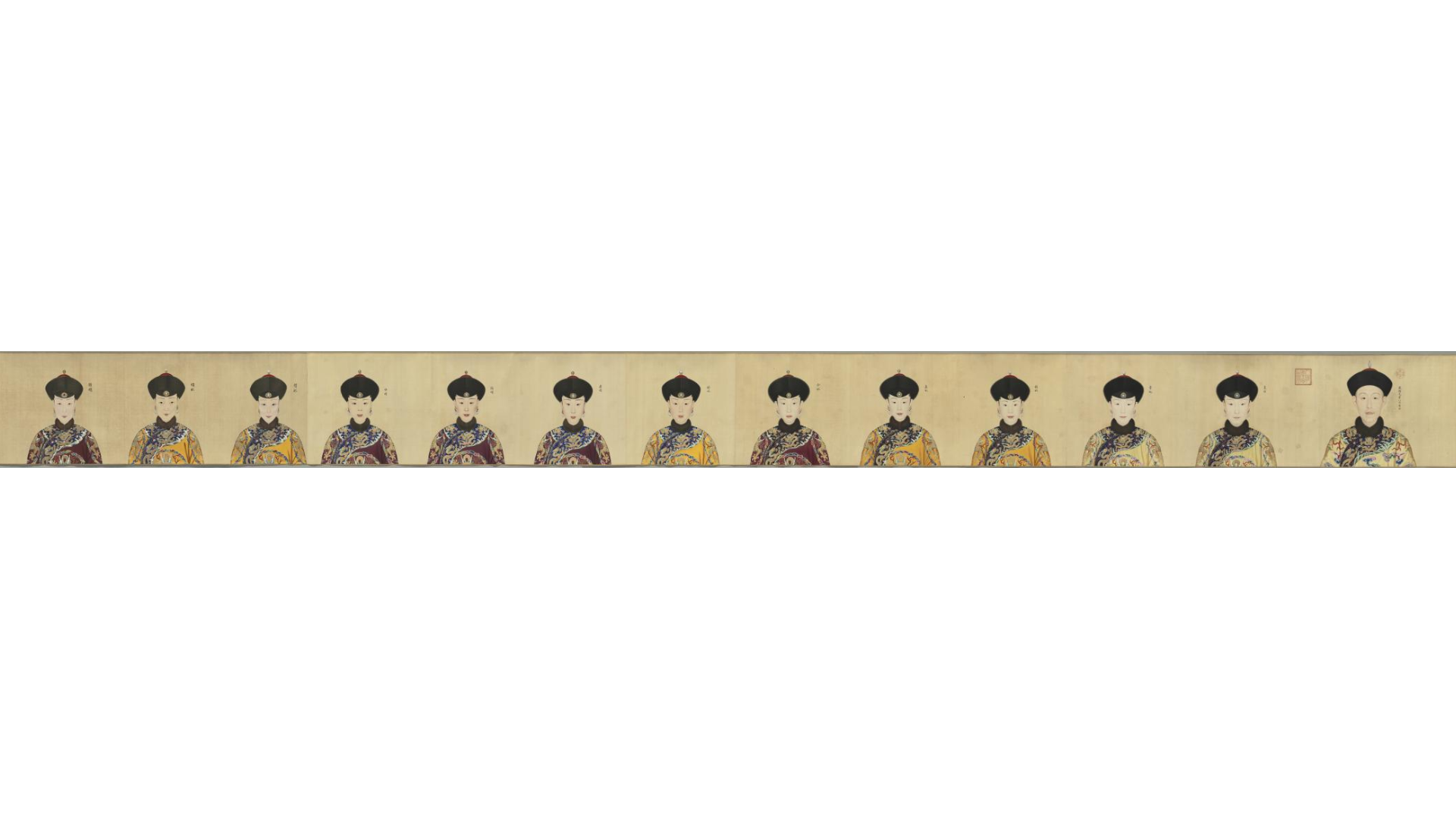



The Empress Xiaoxian in Court Attire, Qianlong period, Qing Dynasty
Provided by the Palace Museum
As recorded in Draft History of Qing, Empress Fuca was virtuous and frugal, despite being of noble birth. On casual days, she would wear flower ornaments handmade from rice-paper plant instead of expensive jewelry.
The Qianlong Emperor attributed his being able to focus on matters of government and having the spare time to attend to the imperial archives to the capable assistance of his good wife and empress, whose posthumous name was "Xiaoxian".

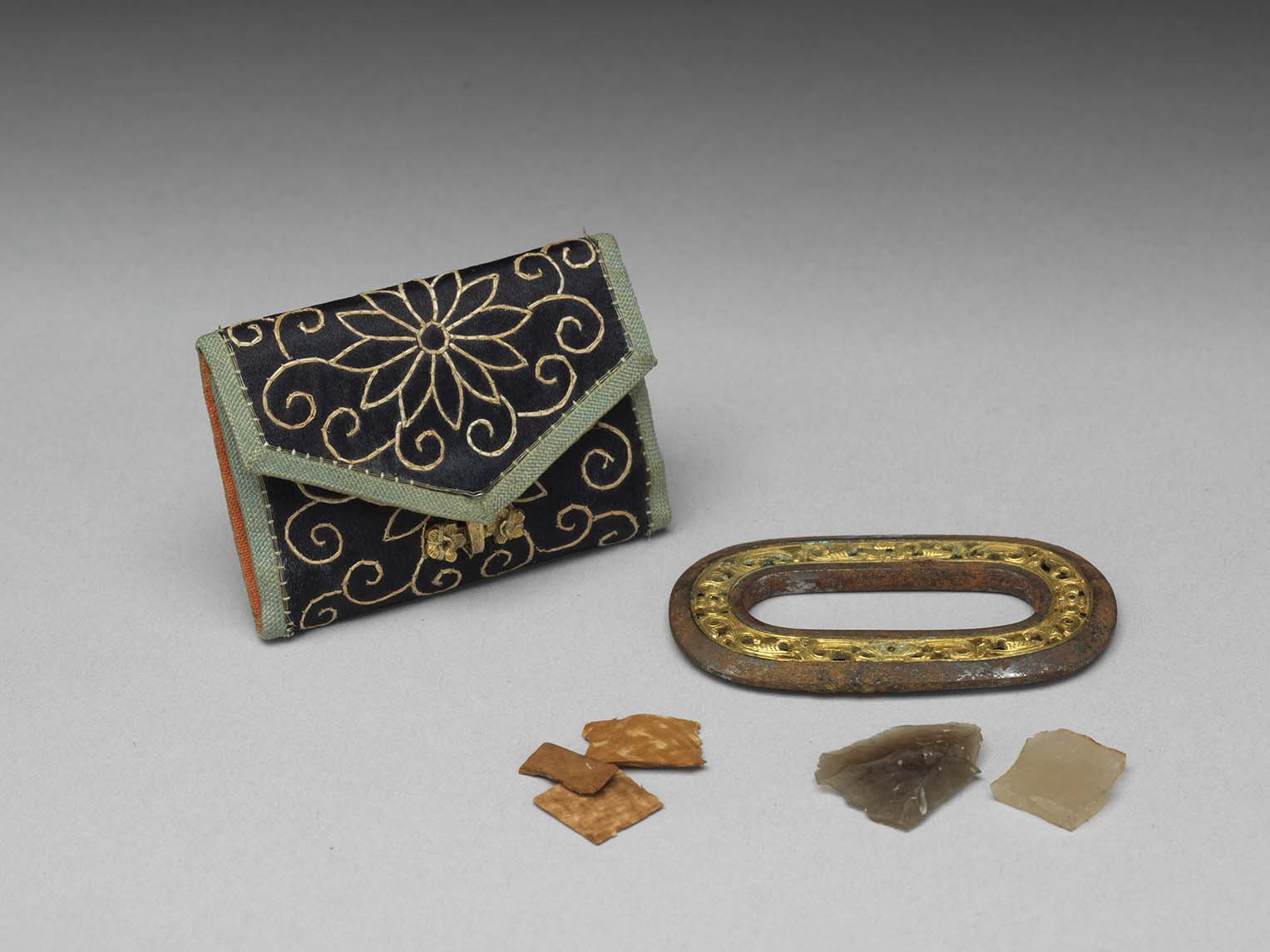
Flint pouch embroidered with floral pattern by Empress Xiaoxian, Qianlong period, Qing Dynasty
From the collection of the National Palace Museum, Taipei
The Qianlong Emperor once read about his ancestors' sewing with the fine hair of deer tail instead of golden thread when they were out in the north. He told his empress about this, expressing his appreciation of the frugality of his forefathers.
So the empress made a pouch sewn with the fine hair of deer tail for the emperor to carry flint when going hunting. This serves to remind Qianlong to follow the frugal example of his ancestors.
The Empress passed away the following year. On seeing this pouch again, the Qianlong Emperor had mixed feelings and wrote, "Alas, all these have become things of the past. I can't hold back my tears."


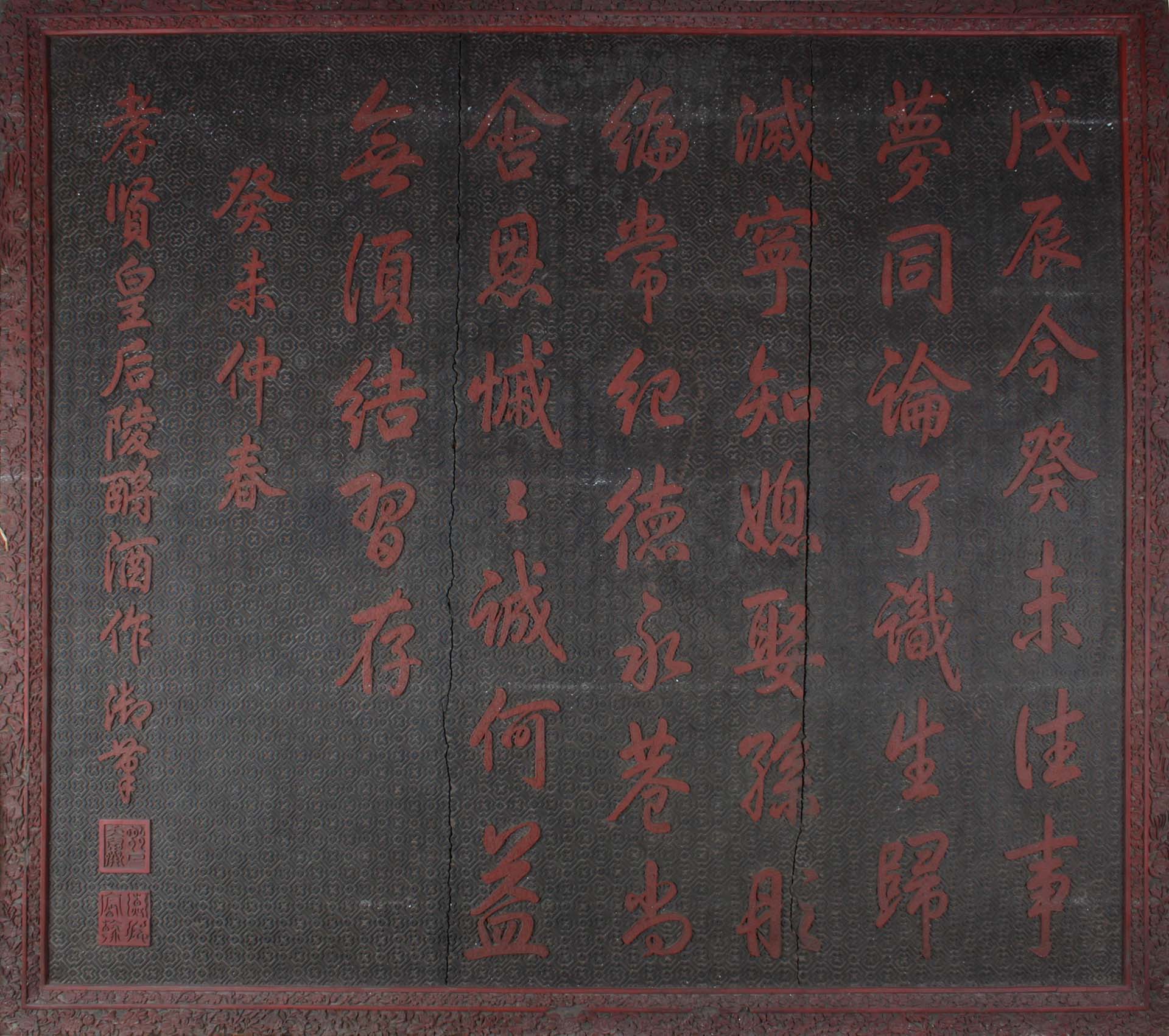
Carved lacquer panel, Qianlong period, Qing Dynasty
Provided by the Administration Department of Cultural Relics in Eastern Tombs of the Qing Dynasty
After Empress Xiaoxian's burial in Yuling Tomb, the Qianlong Emperor often went there to pay his respects. He wrote poems every time he was there and gave order for some of these poems to be made into carved panels, some of which to be placed in the palace and others to be left in the tomb to accompany the empress.
Qianlong would write elegies to his late wife on Buddhist scripture paper, a kind of durable paper with pattern traced with gold specially used for writing scriptures. This is also a gesture that shows Qianlong held Empress Xiaoxian in high regard.


Picking Mulberry Leaves, the third volume of Worship of the Goddess of Silkworms, 1744 (Qianlong period, Qing Dynasty)
From the collection of the National Palace Museum, Taipei
Empress Xiaoxian had made offerings at the Altar to the Goddess of Silkworms in the ninth year of Qianlong's reign. More than 20 days after she had passed away, the Qianlong Emperor ordered the creation of this painting on Worship of the Goddess of Silkworms in memory of her. He also ordered for an exquisite gold lacquered cabinet with phoenix pattern to be made especially for keeping the painting. In the summer of the third year after the Empress' passing (1751), he studied the painting again and lamented that although the painting still looked new, he missed her voice and her goodness as it seemed to be so long ago.
The worship of the Goddess of Silkworms stopped for six years. During the period, Qianlong did not allow other consorts to make the offerings, not even the Step Empress Nara (1718-1766). It was only later in consideration of the need to observe the rites of the nation that the practice was resumed. When Empress Nara was making offerings at the Altar of the Goddess of Silkworms, Qianlong thought of Empress Xiaoxian again and wrote a poem on the painting Making Clothes, "Now we resume clothes making and the worship of the Goddess of Silkworms. I can't bear looking at them getting silk from the water for reeling – it reminds me of my beloved Empress." The poem is followed by an inscription, "Thinking of my beloved and what she used to do at this time of the year, it makes me so sad."
Gold lacquered cabinet with phoenix pattern, Qianlong period, Qing Dynasty
Provided by the Palace Museum





Azure blue satin court vest embroidered with gold dragons and padded with cotton, Qianlong period, Qing Dynasty
Provided by the Palace Museum
After Empress Xiaoxian had passed away, the Qianlong Emperor ordered that the Palace of Eternal Spring be maintained in the manner as the Empress had kept it. Her dresses and crowns were kept there in her memory. Every year until he abdicated, Qianlong would mourn at the Palace of Eternal Spring on the anniversary of her death.
In the 55th year of his reign (1790), the 80-year-old Qianlong Emperor went to visit the tomb of the Empress Xiaoxian, who passed away 42 years earlier. There, he composed a poem expressing his desire to see his wife in the afterlife in perhaps twenty years' time. He lamented how time flew by, whether summer days and winter nights, the sadness of heart could still be felt.

The Guangxu Emperor
and
Empress Longyu
In the eleventh year of Guangxu's reign (1885), the Empress Dowager Cixi (1835-1908) issued a decree announcing the selection of women for the Guangxu Emperor (1871-1908)'s harem to be held in the following year. Fifteen candidates remained after six selection rounds, including the future Empress Longyu (1868-1913) and Consort Zhen (1876-1900). Empress Longyu's father was the younger brother of Empress Dowager Cixi, meaning she was the empress dowager's niece by blood and the emperor's cousin. Qing customs held that the woman selected to be empress would be given a ruyi sceptre, while the consorts would be given a pair of red embroidered pouches. According to the Qing eunuch Tang Guanqing, Guangxu initially favoured the two daughters of the governor Dexin – the future Consort Zhen and Consort Jin (1874-1924) – but under pressure from the Empress Dowager Cixi, it was Empress Longyu who received the ruyi sceptre.
Palace Museum 100: the Selection of Empress
Retrieved from: CCTV Documentary Channel on YouTube
In 1888, the 18-year-old Guangxu Emperor is going to select his empress and gets ready to take over the power. Watch the video to check who will be his empress.
Palace Museum 100: The Wish of Crystal
Retrieved from: CCTV Documentary Channel on YouTube
Is a terrific wedding the code for a happy marriage? Watch the video to check why Empress Longyu moved to Tishun Tang from Zhong Cui Gong where an empress should live?

Photo of Longyu, 1903
Provided by the Palace Museum
In his book Court Life in China: the capital, its officials and people*, the American missionary Isaac Taylor Headland (1859-1942) relayed his wife's description of Empress Longyu's appearance: "Empress Longyu is not at all beautiful... She is rather stooped, extremely thin, her face long and sallow, and her teeth very much decayed."
*Isaac Taylor Headland. (1909). Court life in China: the capital, its officials and people, New York: Fleming H. Revell Company, p. 202.


Photo of Consort Zhen (Attributed), Circa 1894-1898
Provided by the Palace Museum
Consort Zhen of the Manchu Bordered Red Banner was the daughter of Changxu, the Left Vice Minister of Rites.


Ruyi sceptre with double happiness motifs, Guangxu period, Qing Dynasty
Provided by the Palace Museum
In the fifteenth year of Guangxu's reign (1889), the emperor and Empress Longyu held a grand wedding which cost 5.5 million taels of silver. Ruyi means "as you wish", and this ruyi sceptre with the character for double happiness was used during the wedding ceremony to bestow good fortune on their marriage.


The character for "dragon", written by the Empress Dowager Cixi, Guangxu period, Qing Dynasty
Provided by the Palace Museum
The dragon was a symbol of the emperor during the Qing Dynasty. A scroll with the character for "dragon" written by the emperor had to be placed in advance on the phoenix sedan chair that carried the empress into the palace, indicating that she was chosen by the emperor. However, Empress Longyu's scroll was written by the Empress Dowager Cixi.


Flint pouch with double happiness motif, Guangxu period, Qing Dynasty
Provided by the Palace Museum
Flint was originally used for igniting fires during hunts, and the pouch for storing flint was a traditional symbol of the lifestyle of the ancestors of the Manchurian Qing imperial family, who lived in the area to the north of China beyond the Great Wall. This extravagant flint pouch is embroidered with gold thread and was used during the wedding of the Guangxu Emperor and Empress Longyu.


Red satin embroideries with happiness and longevity motifs, Guangxu period, Qing Dynasty
Provided by the Palace Museum
Exquisite items and accessories were used during imperial weddings. This set of embroideries were used for the Guangxu Emperor's wedding, and includes a fan cover, a pair of purses, a tobacco pipe cover, a betel nut bag, a powder box cover, a case for cards or letters carried in boots, a mirror cover and a timepiece cover. The delicate glass cover is decorated with a design of five bats surrounding the character for "longevity", which symbolises happiness, longevity and harmony.


Dragon and phoenix bridal veil, Guangxu period, Qing Dynasty
Provided by the Palace Museum
This bridal veil is used by Empress Longyu. The red satin body is embroidered with auspicious designs of bats and gourds, with a dragon and phoenix motif in the centre drawing attention to the wearer's imperial status. Two-coloured tassels are attached at the four corners.


Embellished flower pot soled shoes with longevity motifs, Guangxu period, Qing Dynasty
Provided by the Palace Museum
The shoes are made of a combination of bright imperial yellow and plain black satin, appliquéd with a blue silk ribbon with white floral patterns. The vamps are decorated with padded appliqué bats and floral motifs. The technique involves cutting the coloured silks and satins according to a predesigned pattern, glueing them onto the body and then stitching the shapes, creating a strong sense of volume. The platforms are decorated with glass beads of various colours that form the characters for "ten thousand" and "longevity" as well as a "blessings before the eyes" motif, conveying good fortune and longevity. These shoes were worn by the Empress Longyu.


Red woollen embroidered kang bed-stove blanket, Guangxu period, Qing Dynasty
Provided by the Palace Museum
A woollen blanket used during the Guangxu Emperor's wedding, featuring a dragon and a phoenix design around a double happiness motif, symbolising prosperity. Gourds represent fertility and blessings, while the endless knot motifs at the four corners symbolise the unity of hearts.
However, the grand wedding and splendid congratulatory gifts did not bring about a happy marriage for the Guangxu Emperor and Empress Longyu.
In order to bring Empress Longyu and the Guangxu Emperor closer together, the Empress Dowager Cixi moved Empress Longyu, who was supposed to live in the Palace of Accumulated Purity, to the Hall of Consolation to the east of the Hall of Mental Cultivation. The Guangxu Emperor, on the other hand, placed Consort Zhen in the Hall of Swallow's Happiness to the west of the Hall of Mental Cultivation; one to the east, one to the west, each favouring one over the other.








